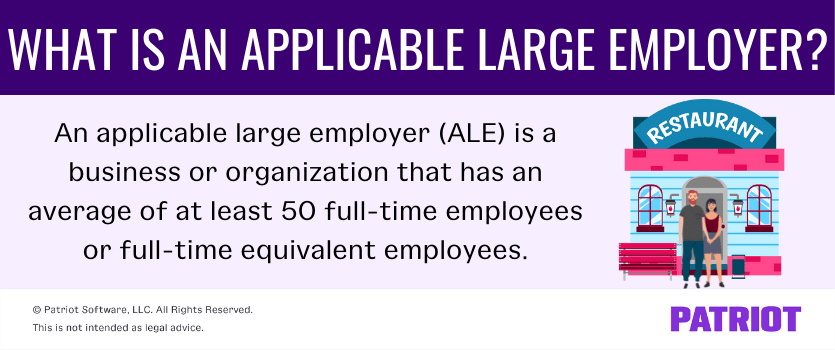When you’re an applicable large employer, you have to follow specific rules. But, how do you know if you’re an applicable large employer? And, which regulations do you have to follow? Welcome to your ultimate applicable large employer guide.
What is an applicable large employer?
An applicable large employer (ALE) is a business or organization that has an average of at least 50 full-time employees or full-time equivalent employees (FTEs). You base the average on the number of employees from the preceding year.
Under the Affordable Care Act (ACA), ALEs must offer employer-sponsored health insurance to all of their full-time employees. If an ALE does not provide health insurance, it may be subject to a penalty. ACA rules also state full-time employees are employees who work at least 30 hours per week or 130 hours per calendar month.
ALEs are subject to the employer shared responsibility provisions. Under the employer shared responsibility provisions, ALEs must do one of the following:
- Offer minimum essential coverage that is “affordable” and provides “minimum value” to full-time employees and employees’ dependents OR
- Potentially make an employer shared responsibility payment to the IRS
For more information on rules, check out the ACA Information Center for Applicable Large Employers.

ACA applicable large employer and full-time equivalent employees
So, what exactly is a full-time equivalent employee? A FTE employee is a combination of part-time employees. When you add together multiple part-time employees, you can create FTE employees.
In the case of the ACA, you need to know your full-time equivalent employees to determine if you’re an ALE. You may also need to know your FTE employees for COBRA, loans, and tax credits.
To be considered an ACA applicable large employer, you do not have to have 50 full-time employees or equivalents at all times. As long as your business has an average of 50 or more full-time or FTE employees during the previous year, it is an ALE. If your business did not have at least 50 full-time or full-time equivalent employees in the prior year, you are not considered an ALE for the current year.
Who not to count for FTEs
There are some employees you should not count when calculating your FTEs. This includes:
- Sole proprietor
- Partner in partnership
- 2% S corporation shareholder
On the other hand, you do need to count seasonal employees in your FTE calculation. However, an employer with seasonal workers may be able to avoid ALE status if the:
- Employer’s workforce exceeds 50 full-time employees for 120 days or fewer during the calendar year AND
- Employees during the 120-day period were seasonal workers
Applicable large employer calculation
You are probably wondering, Am I an applicable large employer? To help answer this question, you need to know how to calculate your full-time equivalent employees.
Again, ACA rules state full-time employees work at least 30 hours per week or 130 hours per calendar month. To find how many full-time equivalent employees your business has and if you’re an ALE, complete these steps:
- Calculate the number of FTEs (including seasonal workers) for each calendar month in the previous year
- Multiply the number of part-time employees you have by the number of hours they work per month
- Divide the total hours worked by part-time employees by 120 hours (30 hours for full time X 4 weeks in the month)
- Repeat above steps for each month
- Add together your total full-time and FTE employees for each month
- To find your average for the year, add together your total full-time employees and FTEs per month and divide your total by 12
If you have 50 or more FTEs for the previous year, you are an ACA large employer for the current year. You should calculate your FTEs each year to determine if you’re an ALE for the new year.
ALE FTE calculation examples
Check out a couple of examples of calculating FTE to find out if you’re an applicable large employer.
Example 1: ALE
Say you have 25 full-time employees. You also have 15 part-time employees who each work approximately 48 hours per month.
To calculate how many FTEs you have, multiply the number of part-time employees you have (15 employees) by the number of hours they work per month (48 hours).
15 part-time employees X 48 hours = 720 hours
Divide the total hours worked by part-time employees (720 hours) by 120 hours (30 hours for full time X 4 weeks) to determine how many full-time equivalent employees you have for the month.
720 hours / 120 hours = 6 employees
Add together your full-time (25) and FTE part-time employees (6) to get your total full-time equivalent employees.
25 full-time employees + 6 FTE part-time employees = 31 FTEs
You have 31 full-time equivalent employees for this month (let’s say it’s for January). Repeat the above steps for the remaining months of the previous year. After you do this, you find the following:
- January: 31 FTEs
- February: 38 FTEs
- March: 45 FTEs
- April: 53 FTEs
- May: 57 FTEs
- June: 60 FTEs
- July: 64 FTEs
- August: 59 FTEs
- September: 55 FTEs
- October: 53 FTEs
- November: 48 FTEs
- December: 40 FTEs
To find your FTEs for the year, add together your totals for each month and divide by 12 to get the average.
31 + 38 + 45 + 53 + 57 + 60 +64 +59 + 55 + 53 + 48 + 40 = 603
603 / 12 = 50.25
You have 50.25 FTEs for the previous year. Because you have at least 50 FTEs, you are considered an ALE.
Example 2: Not an ALE
Say you calculate your FTEs for each month of last year. You get the following:
- January: 38 FTEs
- February: 40 FTEs
- March: 45 FTEs
- April: 47 FTEs
- May: 50 FTEs
- June: 52 FTEs
- July: 52 FTEs
- August: 55 FTEs
- September: 53 FTEs
- October: 50 FTEs
- November: 50 FTEs
- December: 44 FTEs
You add together your totals for each month and get 576. Divide your total by 12 to find your average for the year.
576 / 12 = 48
You had an average of 48 FTEs for the year. Because it’s not 50 or more, you are not considered an ALE for the current year.
Applicable large employer reporting
Under the employer information reporting provisions, an ALE must do the following:
- Report information to the IRS about health care coverage offered to full-time employees
- The IRS uses this information to administer the employer shared responsibility provisions and premium tax credit
- Furnish a statement to employees that includes the same information provided to the IRS
- Employees can use this information to determine if they can claim the premium tax credit on their income tax returns
- File returns electronically if they file 250 or more information returns during the calendar year
Form 1095-C, Employer-Provided Health Insurance Offer and Coverage, is a mandatory form that applicable large employers must file. The form includes information about the health coverage for the employee, including the cost and covered months. Employers must send Forms 1095-C to employees and the IRS.
ALEs must complete a 1095-C form for all full-time employees, regardless of whether or not they had coverage. Send Form 1095-C to your employees by January 31. Mail Form 1095-C to the IRS by February 28. If you file electronically, the form is due by March 31.
For more information on reporting requirements, check out the IRS’s Q&A.
This is not intended as legal advice; for more information, please click here.




